Saturn is a favorite of the backyard astronomer.
When asked what it was that influenced our
curiosity, it is usually seeing Saturn for the first
time in the eyepiece of a
telescope. While the moons
of Saturn are not as discernable in the eyepiece,
the rings most certainly are. Cloud patterns are
present but not as dramatic at
Jupiter. Non the
less, it is still a wonderful object to admire.
Much of the scientific data will no doubt be
challenged by the data from the Cassini-Huygens -
for example the magnetic field is much stronger than
originally
modeled. Such changes will have an
outcome on our current internal structure and
atmosphere dynamics of this planet. But much of the
data remains valid.
What about the idea of Saturn floating in water?
Well, the
density of water is 1000 kg/m3
and Saturn has a
density of only 687 kg/m3
- that means if there was a body of water large
enough to hold Saturn, it would float!
Saturn - A Quick Summary: (More information can be found on the Saturn Fact Sheet)
 |
Average Distance from Sun: |
1.432 x 109 km |
| Eccentricity of Orbit: |
0.053 |
| Average Orbital Speed: |
9.64 km/s |
| Orbital Period: |
29.37 years |
| Rotational Period
(equatorial): |
10h 13m 59s |
| Inclination of Equator to
Orbit |
26.73º |
| Diameter: |
120,536 km |
| Mass: |
1.899 x 1027 kg |
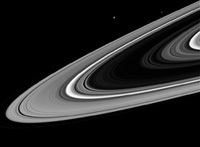 |
Average Density: |
687 kg/m3 |
| Escape Speed: |
35.5 km/s |
| Albedo: |
0.46 |
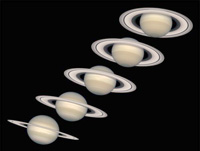 |
| Average Cloud-Top
Temperature: |
-108º C |
| Atmospheric
Composition: |
96.3% hydrogen |
| 3.3% helium |
| 0.4% methane |
| ammonia |
| water vapor |
| trace elements |
Back to Top The Atmosphere: The
chemical composition of Saturn is similar to
Jupiter but with different quantities. Compare Saturn's
96.3% hydrogen to
Jupiter's 86.2% hydrogen for
example. Differential rotation occurs on both
planets and it is believed that the same belt and
zone patterns exist:
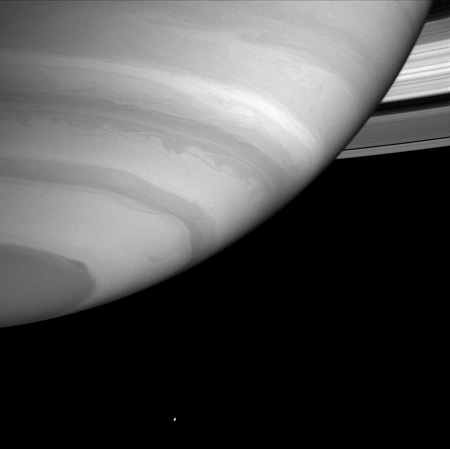
The above black and white image enhances the cloud
patterns. Saturn is smaller than
Jupiter but releases
25% more internal heat resulting in wind speeds
reaching up to a phenomenal 1800 km/h. The image
below demonstrates the atmosphere of the Gas Giants,
including Saturn:

The image above provides much information like gross
composition,
temperature and altitude. One may notice
immediately that the clouds of Saturn are more pale
than
Jupiter. While the chemical composition may
cause this, the main reason is a layer of haze,
composed of mostly ammonia, lies above the clouds
acting as a filter.
Back to Top Internal
Structures: Saturn and
Jupiter share very similar internal structures, with the
only variation being content:
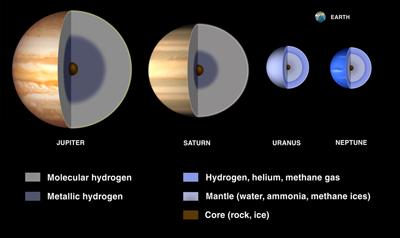 The interiors of both
Jupiter and Saturn give
them both strong magnetic fields and very large
magnetospheres, mostly because only
Jupiter and
Saturn contain liquid metallic hydrogen.
New Images: Resent infrared images from
the Cassini orbiter revealed two interesting finds:
the methane in Saturn's atmosphere gives an almost
Jupiter-like appearance, and some unusual active
spots have been discovered at the poles.
 |
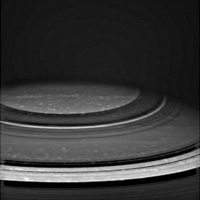 |
| Methane gives Saturn a
Jupiter
appearance |
Active spots in the
infrared in the polar regions on unknown
origin - probably hot spots. |
This February 2005 image shows the
best portrait ever of the ringed planet:
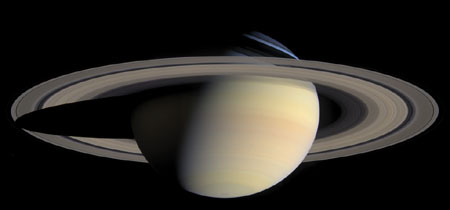
This image was taken when Saturn was between the Cassini Probe and the Sun:
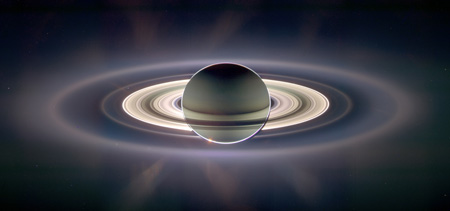
Back to Top |

